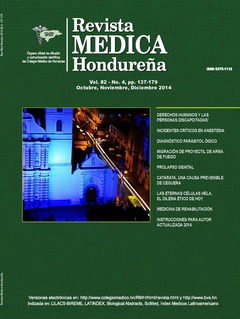Cataract, a preventable cause of blindness, and the prioritized research topics in ophthalmology in Honduras
Keywords:
Blindness, Cataract, Vision disorders, Visually impaired persons, Vision, lowAbstract
Cataract, a total or partial opacification of the lens, is the main cause of bilateral blindness and serious visual impairment, being a treatable cause. The diagnosis is made by direct observation of opacity, in an ophthalmologic clinic or at home with a hand flashlight. In 2010, according to the World Health Organization, 285 million people worldwide suffered from visual impairment and 39 million of them were blind. The leading causes of blindness includes cataract (39%), refractive errors not corrected (18%) and glaucoma (10%). Blindness by cataract incapacitates the individual and their caregivers, causing an impact in the family and in society. Its surgical treatment is considered one of the most cost-effective health interventions, comparable with the vaccination. However, the offer of surgery is very uneven around the world. It is the surgery most frequently performed in the elderly in developed countries, but in developing countries face many barriers as lack of availability of surgery services, difficult access or ignorance that treatment is possible. The annual number of surgeries needed to eliminate cataract blindness is about 2,000-4,000 per million of inhabitants. In Latin America, Honduras and Guatemala have a considerable reduction in the theoretical number of surgeries of cataract with the lowest number of ophthalmologists per million inhabitants. Through a research agenda with prioritized topics, the Faculty of Medical Sciences UNAH and the health services should contribute to the development of public policies that enable the implementation of ocular health programs in Honduras.
Downloads
455




